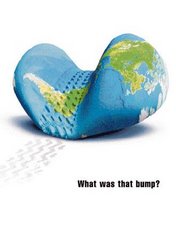So I was talking to a friend a few weeks ago, who was telling me about plastic products and how some of them are being shown to contain Very Scary Chemicals. I had heard about this in regards to baby bottles, but didn't pay much attention since my kids never really had bottles. Well, I have since also gone to the pediatrician (anyone who is counting out there, Emmett is still like 93rd percentile for weight, weighing in at 20 lbs 11 oz at 6 months) and she was mentioning the plastics thing again. I have been confused, but now I know the deal, and so I am going to share it with you.
I heard a
story on NPR the other day about plastic water bottles. A shocking and sad statistic is that only 23% of these individual-portion water bottles get recycled. And these bottles, recycled, are just as valuable as the first-run versions! Everyone wants these recycled bottles. It is sad when there is such a demand for a post-consumer recycled product, but nobody is recycling it. Well, people shouldn't buy their water in freaking little bottles, either. I mean, really! You can bring a bottle with you and re-fill it, or if you don't like tap water, fill it at home. Bottled water is the biggest rip-off ever. Brands like Aquafina and Dolsane (or whatever they are called--the coke and pepsi bottled waters) aren't even "spring" water. They are just purified tap water. If you really can't do tap, then buy it in huge, re-fillable 10 gallon jugs. You can even get it delivered! I, myself, like tap water.
Ok, so back to the thing about how plastics are scary. Here is the deal: many plastics contain a chemical called Bisphenol-A or BPA. This chemical is an endocrine-disrupting hormone that probably causes cancer, early puberty, developmental delays in children, etc. There is evidence that this chemical leeches into foods we eat or liquids we drink from the plastics that contain it. But there is good news! Not all plastics contain it. Sadly, almost all baby bottles and sippy cups do. So the most vulnerable among us are the ones getting it. What is wrong with people? Why are we putting Scary Cancer-Causing chemicals in baby bottles?
So here is the break-down. Look at the bottom of your plastic cup, tupperware container, or sports bottle. If it is a #7, it probably contains BPA and you should get rid of it. THIS INCLUDES NALGENES. I know, i know. Its sad and horrible. We all thought lexan was the greatest thing ever. Plus, all those healthy people carry their Nalgenes with them wherever they go. But they are not safe. Especially not for hot liquids. I cringe when I recall that i have put coffee in mine on more than one occasion. #7 plastics are ok if they are labeled "bio-based" plastic.
There are several other kinds of plastics we should not use. We should not buy them because they should not be made. We do not want these Scary Chemicals in our environment, in our children's bodies. It is unacceptable to use these chemicals, and the makers need to know that.
#3 plastics: Bad. contains DEHA (di(2-ethylhexyl)adipate) which is known to cause liver cancer. With a name like that, you
know you shouldn't be using it! Also found in cling-wrap. Don't use cling wrap. Especially don't microwave it! This chemical is now found in our air, food, water and bodies. Not ok. #3 is also PVC or polyvinylchloride. This is a bad, bad thing. We do not want PVC in our lives. If your children's toys contain PVC, please do them a favor and get rid of them.
#6 plastics: Bad. Contain styrene which is toxic to the brain and nervous system.
Again #7 plastics, Bad. So many studies show this. Get rid of it. Don't buy it.
Go look at your child's sippy cup. If it says #3, 6, or 7, get rid of it and replace with:
Plastics #1, #2, #4 and #5 are all OK. No known endocrine-disrupters. No cancer. They are still plastics, but they are less evil than the other ones.
If you need alternative sippy-cup sources, please check out this great
blog article on the subject. There is also a company called "Born Free" that is making BPA-free bottles and sippy cups. I'm too lazy to google it. You do it! If you aren't sure because it isn't labeled, this quick test will let you know whether your stuff contains BPA--is it hard and clear? Or is it squishy or soft-ish and cloudy? If it is hard and clear (think colored Nalgene) it contains BPA.
Here is a full article about which plastics are ok and which aren't and more info on why they aren't ok.
While you are at it, get rid of your teflon pots and pans. Teflon is also a Scary Cancer-Causer.
We are slowly replacing everything teflon with stuff that is stainless steel. We are getting rid of all plastic things and using glass, stainless steel or the safer plastics.





